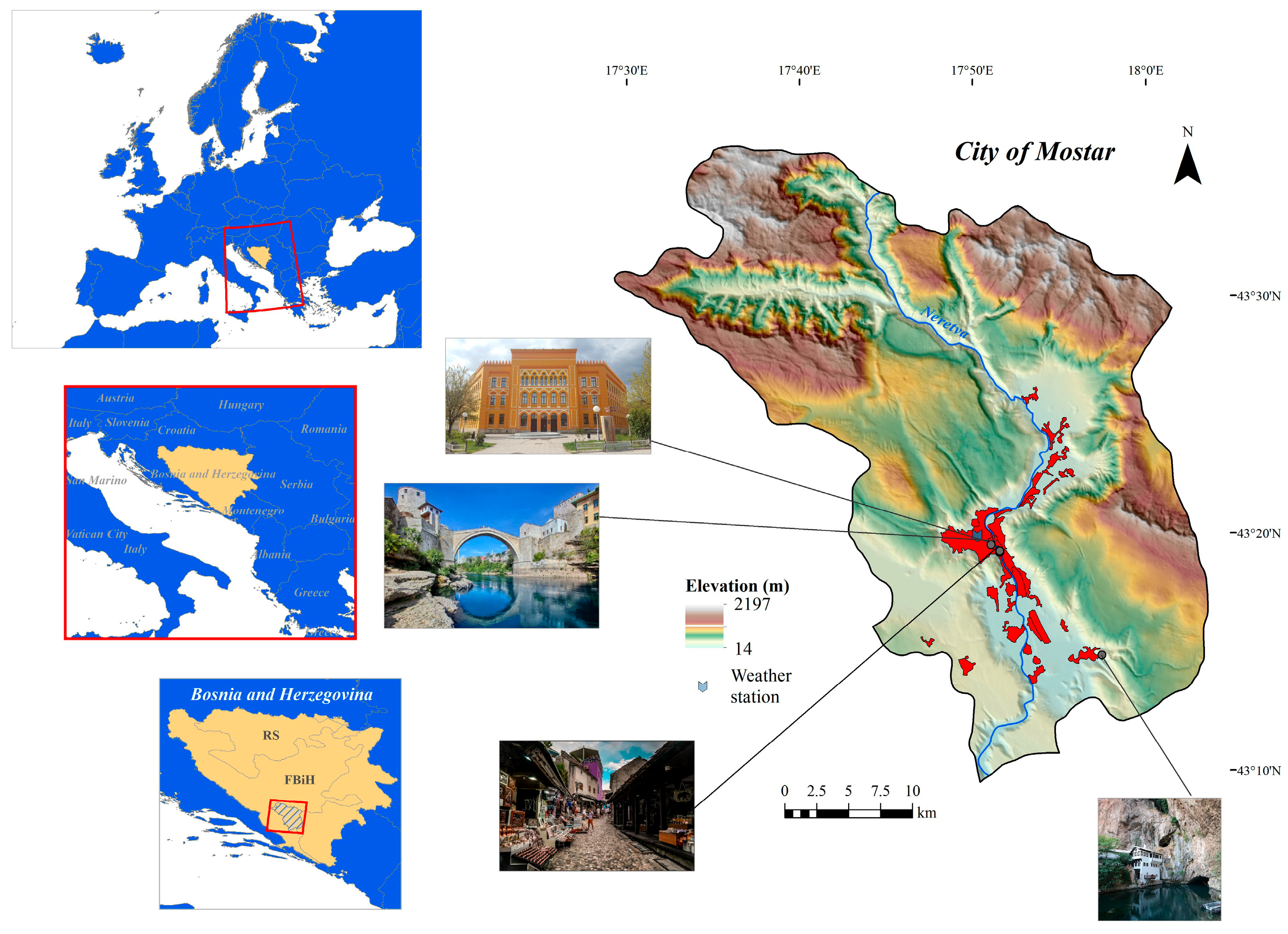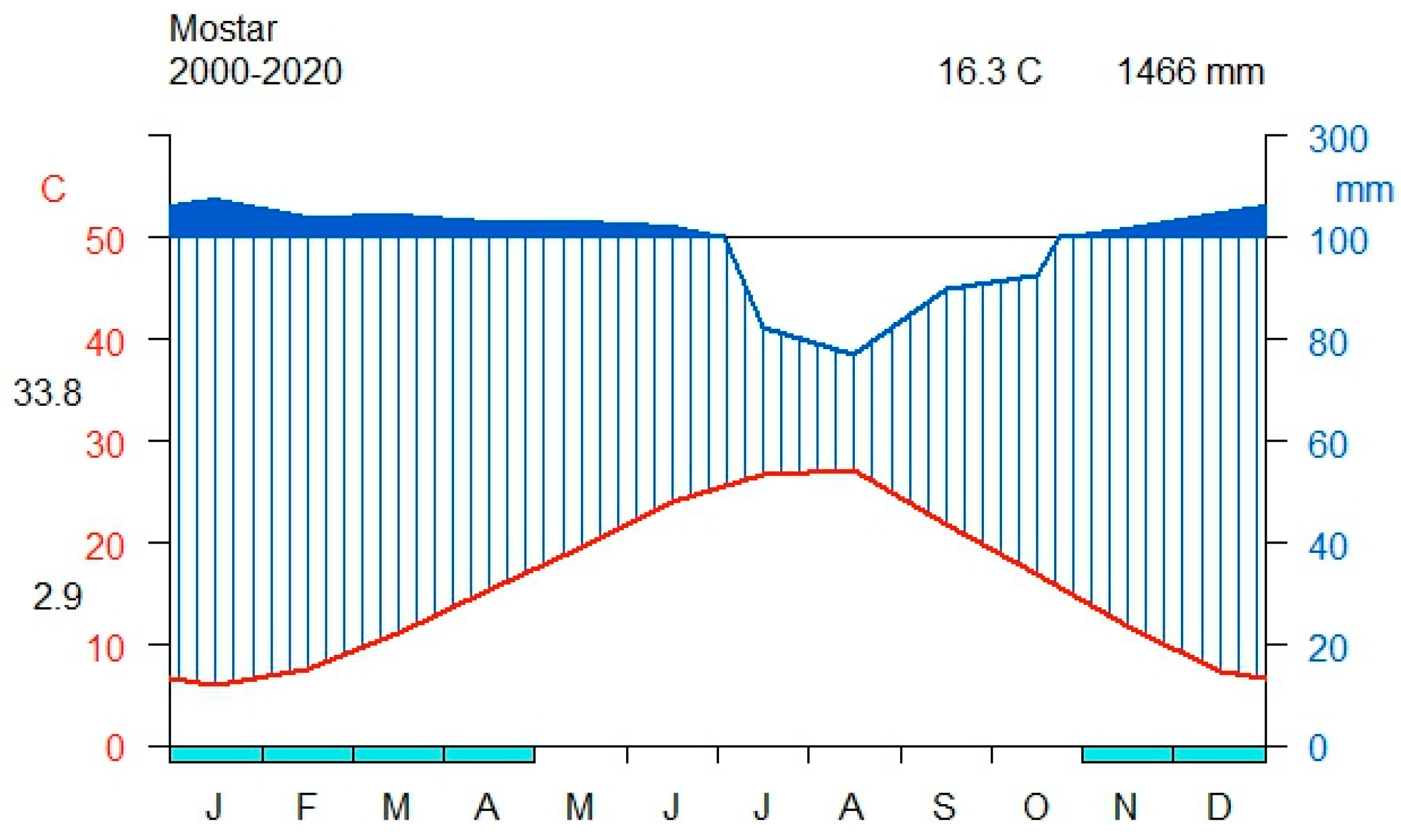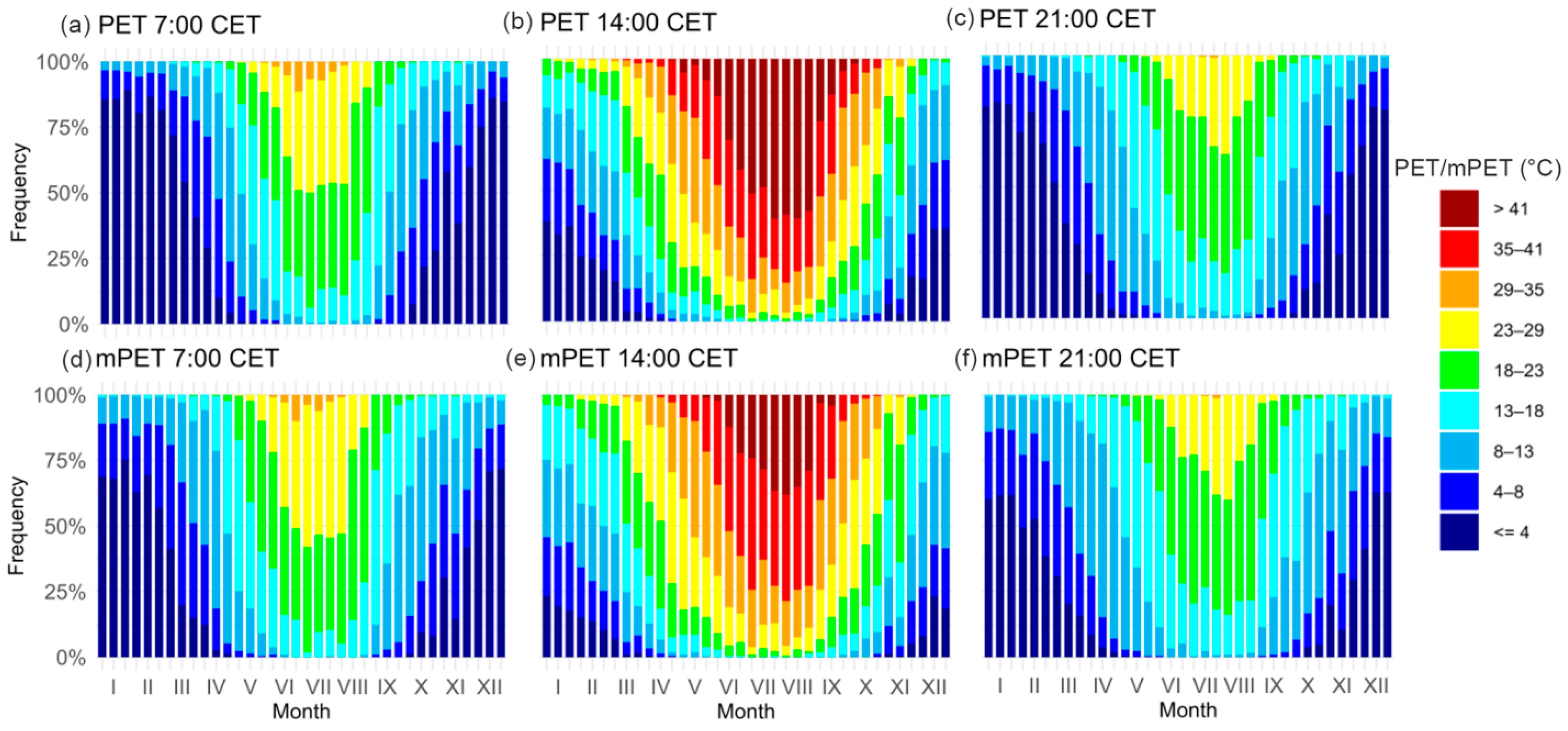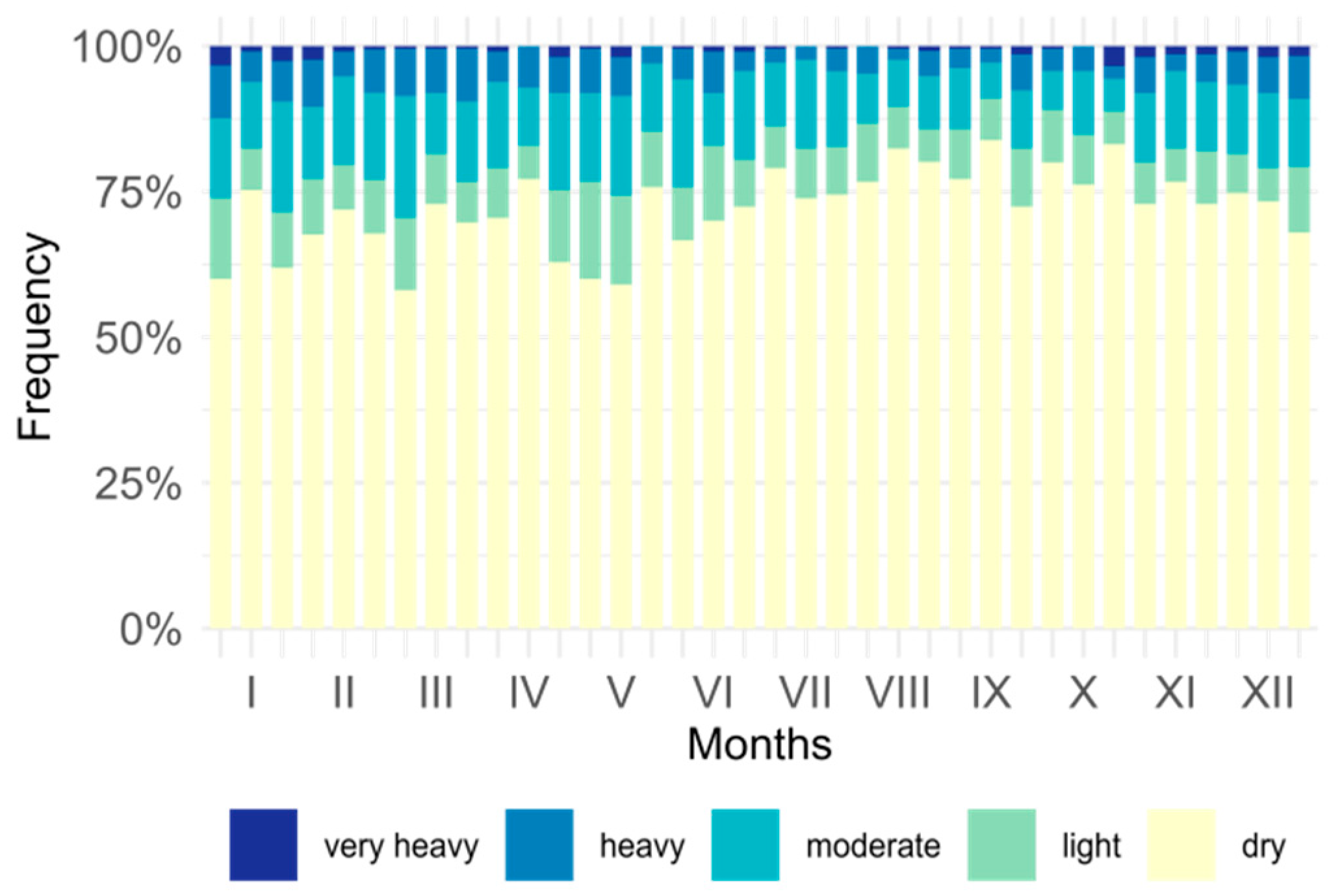1. Introduction
One of the greatest challenges contemporary tourism faces is the ever more frequent and intensive extreme weather events, such as heat waves, cold spells, storms, and other natural hazards, as stated in a report by the World Meteorological Organization [
1]: “Climate indicators set new records. Extreme events cause devastation” [
1]. These events negatively affect tourism infrastructure and endanger natural and cultural resources as well as having the capacity to cause fires, erosion, or transportation disruptions, which impacts the safety and reputation of destinations [
2]. Although heat waves are not globally recognized as the most dangerous type of weather hazard compared to hurricanes or storms, they are to a growing extent becoming a threat regarding local areas, especially in the Mediterranean region [
3]. Such trends highlight the need for the development of sustainable spatial planning that integrates tourism, climate resilience, and environmental protection [
4]. According to earlier reports by the World Tourism Organization [
5,
6], the Mediterranean region—geographically including the city of Mostar—represents the world’s leading tourist destination, attracting one-fifth of all international arrivals and generating over 30% of global tourism revenue. However, climate change threatens this potential, as earlier reports by the Intergovernmental Panel on Climate Change [
7] already warned of rising temperatures and more frequent heat waves. Recent IPCC reports [
8,
9] confirm that the predictions made in 2007 about rising temperatures and increasing heat waves have nearly been fulfilled. “Climate Change 2021: The Physical Science Basis” and “Climate Change 2024: Synthesis Report” both highlight that extreme heat events have become more frequent and intense, in line with earlier projections [
8,
9].
Contemporary approaches to tourism planning emphasize that climate and weather should be considered key determinants of tourism demand and destination management [
10]. Traditional planning, which relies on monthly average data, often overlooks the impact of short-term weather conditions on tourists’ daily comfort. As shown in the case of Catalonia [
11], linking objective climatic data with visitors’ subjective preferences enables the creation of weather-type catalogues suitable for tourism. As a multisectoral economic activity, tourism is one of the most sensitive sectors to natural and climatic conditions, making it particularly vulnerable to the effects of climate change [
12,
13]. Despite a growing number of studies, tourism is still inadequately prepared for adaptation to pronounced climate disturbances, while weather events are already negatively impacting the attractiveness, competitiveness, and economic sustainability of many destinations. The growing number of tourists during summer months further highlights the importance of analyzing thermal comfort, as high temperatures can adversely affect visitors’ health, time spent outdoors, and the structure of tourist activities [
12]. From a bioclimatological perspective, De Freitas [
14] emphasizes that user needs—both tourists and tourism decision-makers—are often neglected in standard climate analysis approaches. He calls for the development of validated and functional tourism–climate indices that more accurately reflect conditions relevant to tourist experiences and behavior. In this context, the provision and availability of weather and climate information play an increasingly important role in modern tourism, both in terms of travel planning and in terms of visitor safety and comfort. Matzarakis [
15] classifies this information into three key groups: climatological data (monthly averages of temperature, precipitation, number of sunshine hours), real-time meteorological information (e.g., UV index, air quality), and bioclimatic indices that quantify the impact of the environment on the human body. These data enable tourism organizations to more accurately plan accommodation capacities and activities, improve visitor information, and enhance their experience at the destination. The author particularly emphasizes the importance of using simple and visually interpretable formats, such as bioclimatic brochures, which combine thermal, physical, and aesthetic characteristics of weather, making them accessible and useful to the wider public.
Scott and Lemieux [
16] further note the strategic value of climate information for the touristic sector, viewing it both as a resource and as a risk factor. They point to the lack of standardization and systematic application of meteorological information in tourism, emphasizing the need to improve data collection infrastructure in tourism-relevant regions, as well as the development of specific climate services tailored to the needs of destinations. They particularly stress the importance of linking the academic community, meteorological institutions, and the tourism industry in creating integrated systems for managing climate risks and increasing sector resilience. In addition to the objective assessment of conditions, forecasts, risks of extreme events, and long-term climate expectations also play a significant role in shaping tourism demand and planning.
Although classic climate information provides a basis for understanding seasonal patterns, it is often not intuitive enough for widespread use. For this reason, growing attention is being given to the application of bioclimatic indices, which present thermal comfort levels in a comprehensible and operational way. Among these, the physiologically equivalent temperature (PET) has emerged as the most commonly used index in the context of tourism, as it allows direct comparison with temperatures familiar to users and provides clear interpretations regarding potential heat or cold stress. The application of bioclimatic indices has proven valuable in urban areas in Bosnia and Herzegovina [
17,
18,
19,
20]. The application of bioclimatic indices internationally has been complemented by visualizations using the Climate-Tourism Information Scheme (CTIS), which further confirms their value. The CTIS enables visualization of the frequency of favorable and unfavorable thermal, physical, and aesthetic conditions, providing tourists and decision-makers with high-resolution information for visit planning and destination development. An interesting approach was successfully applied in Taiwan [
21] and on the island of Hvar in Croatia, where Zaninović and Matzarakis [
22] produced a bioclimatic leaflet integrating PET, precipitation, solar radiation, humidity, and wind to better inform tourists.
Mostar, a recognizable “city break” destination with rich cultural–historical heritage and Mediterranean influence [
23], has seen a rise in tourist arrivals in recent years—from about 77,000 in 2012 to over 266.00 in 2019—with recovery following the decline due to the COVID-19 pandemic [
24]. However, the city remains vulnerable to climate extremes, which further emphasizes the need for thermal comfort analysis and better integration of bioclimatic information into tourism planning. Although PET, mPET, and the CTIS have been successfully applied in climate and tourism studies, there has been no integrated bioclimatic analysis using these indices for Mostar, a city experiencing rapid tourism growth and pronounced heat stress. This study addresses that gap by providing the first combined assessment for a city experiencing tourism expansion and intensive summer heat. Given all this, the aim of this study was to develop a bioclimatic informational sheet for Mostar tailored to local climatic and geographic specifics using the bioclimatic indices of physiologically equivalent temperature (PET), modified PET (mPET), and the Climate-Tourism Information Scheme (CTIS) with the aim of contributing to sustainable tourism planning, improved information for visitors and decision-makers, and strengthening Mostar’s resilience to climate extremes.
3. Results
This section presents a detailed assessment of the thermal and climatic conditions in Mostar between 2000 and 2020, with a focus on their implications for human thermal comfort and tourism. The analysis is based on four key components: (1) the frequency distribution of PET and mPET thermal stress categories across different times of day and seasons; (2) seasonal patterns of precipitation and its impact on outdoor conditions; (3) the daily and seasonal course of PET and mPET values; and (4) an evaluation using the Climate-Tourism Information Scheme (CTIS) to assess the suitability of weather conditions for tourism. Finally, the findings are synthesized into a practical bioclimatic information sheet designed to support climate-responsive tourism planning.
3.1. Frequencies of PET and mPET
To provide a comprehensive overview of the thermal conditions during three time periods throughout the day between 2000 and 2020, frequency distribution diagrams for nine thermal stress categories of PET and mPET, organized into 10-day intervals, were created, presented in
Figure 3. Considering the afternoon (14:00 CET) observations shown in the middle column of
Figure 3, it is notable that the absence of a thermal stress category is quite rare, particularly during the summer and winter months (less than 10% and 15%, respectively). When it comes to the transitional seasons, favorable thermal conditions are significantly more common than in winter and summer (between 5% in early September and 44% in early November), and they are on average slightly more frequent in spring than in autumn. Heat stress was unrecorded only in January and December, while it prevailed (over 50%) from late April to mid-October. From mid-June to early September, the incidence of heat stress exceeded 90%, with extreme heat stress prevailing for most of that period. Afternoon heat stress was more common in autumn than in spring. Cold stress prevailed from late November to mid-March, with the two weakest stress categories being most represented.
Based on the morning (07:00 CET) and evening (21:00 CET) observations, no thermal stress category was observed from mid-April to the end of October. Considering summer values, no stress conditions were more frequent in the evening than in the morning (up 48.06% and 44.19% for mPET, respectively). When it comes to transitional seasons, favorable morning conditions are more common in spring than in autumn, while in the evening, they are the opposite. Both morning and evening cold stress categories were recorded in all 10-day periods throughout the year, with the most common occurring between September and May. The most intense morning and evening cold stress (strong and extreme cold stress categories) predominates approximately between the middle of November and the end of March. Considering heat stress, only the two mildest categories appear in the morning and evening observations, with the slight stress category being more dominant. Morning heat stress was recorded from early May to late August, while evening heat stress was noted from mid-May to mid-September. Analysis indicated that heat stress is recorded much more often in the morning than in the evening.
3.2. Frequency of Precipitation
Mean annual precipitation during the 2000–2020 period in Mostar is 1467 mm. Precipitation is the most pronounced in winter and spring (468 mm and 412 mm, respectively) and the least in summer and autumn (283 mm and 304 mm, respectively). The month with the most precipitation is January (177 mm), while the month with the least is August (77 mm).
Figure 4 illustrates that the frequency of precipitation ranges from 16.2% (mid-September) to 42% (early March). The average annual frequency of dry days (<1 mm) is 72.19%. Overall, the likelihood of precipitation is higher in the early part of the year, from January to May (frequency > 30%), compared to the rest of the year (frequency < 20%). The average frequency of 20.1% for precipitation events in August is lower compared to other summer months. In general, moderate precipitation rates (5–10 mm) prevail throughout the year, while heavy (20–50 mm) and very heavy precipitation (greater than 50 mm) rates are less frequent. The frequency of heavy and very heavy precipitation is highest from December to March, ranging from approximately 8.7% in March to 9.4% in January.
3.3. Daily Distribution of PET
The daily distribution of PET and mPET presented in
Figure 5 identifies intervals of heat stress from morning through evening, evaluating 10-day intervals within the observed years at the same time.
Figure 5 shows that the warmest days and hours were recorded in July and August between 12:00 CET and 16:00 CET when PET and mPET levels go beyond 35 °C. Hot conditions reach 35 °C from mid-June to late August during the day, while stress above 41 °C is only present in August around 14:00 CET (according to PET). From June to the end of August, mornings and evenings are often comfortable or may induce slight heat stress, with no expectation of cold stress at all. PET and mPET categories below 13 °C occur in the mornings and evenings from late September until early May, and they are present during the day from early November until late March.
It is noteworthy that compared to PET (
Figure 5 left), the frequency of mPET (
Figure 5 right) is somewhat more moderate, indicating a reduced likelihood of extreme heat stress conditions. For instance, during the cold months in the morning and evening, instances of PET below 4 °C are more frequent than those of mPET below 4 °C. Additionally, unlike mPET, summer afternoon PET values fall into the category of extremely severe heat stress (>41 °C).
3.4. Climate-Tourism Information Scheme (CTIS) Diagrams
The CTIS diagrams presented in
Figure 6 integrate thermal, physical, and aesthetic aspects with input data for the period 2000–2020. To provide a clearer understanding of the results and enhance accessibility for potential visitors, the CTIS diagrams for three observing terms were illustrated in two different formats. Initially, percentages for each assessed factor at 10-day intervals were generated and then visually grouped by month (
Figure 6 left-hand graphs). Following this, the evaluated factors were classified as suitable or unsuitable according to the relative frequencies (
Figure 6 right-hand graphs).
A multitude of green cells in
Figure 6 left-hand graphs indicates a high level of suitability for the destination. Extreme cold stress (PET/mPET < 0 °C) is not present during the afternoon observations, while it is rare in the morning and evening. Extreme cold stress in the morning and evening, with more than 20%, but less than 60% of days, persists from the beginning of October to the end of March based on PET (from late November to early March, according to mPET). Strong and extreme heat stress (PET/mPET > 35 °C) occurs during the afternoon measurement period from the beginning of May to the end of September (according to PET) or from the end of May to mid-September (according to mPET). In June and August, strong and extreme heat stress occurs in the afternoon observations for more than 75% of the days. The chance of afternoon thermal acceptance (18 °C < PET < 29 °C) is highest in April and October, while it occurs in the morning and evening from mid-May to mid-September. The destination is often sunny, especially from May to October when the possibility of cloudiness <5 octas is greater than 50%. From late April to mid-September, a higher level of sultriness, ranging from 20% to 70%, is noticeable, diminishing favorable morning and evening conditions while worsening afternoon conditions. Fog can occur in every month except summer, although it is quite rare (up to 20% in autumn mornings), and it tends to be more common in the morning than in the evening. The likelihood of precipitation less than 1 mm is dominant throughout the year (over 60%), surpassing 70% from late May to mid-December. The probability of precipitation exceeding 5 mm, which could negatively affect tourism activities, ranges from 10% to 30%, with the highest frequency (over 20%) occurring from mid-December to the end of May. The frequency of strong winds is under 5%.
3.5. Human Bioclimatic Information Sheet
To support the interpretation and practical application of the research findings, a bioclimatic information sheet for Mostar was developed as
Supplementary Material to this study in the form of a poster to consolidates all findings of the study into a single visual guide (see
Supplementary Material Figure S1: Bioclimatic Information Sheet). It translates complex results into accessible information for tourists and planners. This visual guide integrates key findings from the analysis of physiologically equivalent temperature (PET), modified PET (mPET), and the Climate-Tourism Information Scheme (CTIS) in a format designed for both scientific interpretation and practical use. It is designed to provide seasonally and diurnally resolved insights into thermal comfort and relevant climatic factors in a format accessible to tourists, planners, and decision-makers alike. In addition to offering practical recommendations—such as promoting shoulder seasons and developing adaptive infrastructure—the sheet also reflects a scientifically based bioclimatic analysis based on standardized methods and validated indices, thus providing a valid basis for sustainable tourism planning in the face of ongoing climate change. Its practical relevance is further explored in the discussion section, where the bioclimatic information sheet is positioned as a key tool for climate-informed tourism management in the city of Mostar.
4. Discussion
This study aimed to conduct a detailed analysis of the bioclimatic conditions in Mostar using the physiologically equivalent temperature (PET) index, the modified physiologically equivalent temperature (mPET) index, and the Climate-Tourism Information Scheme (CTIS) over the period 2000–2020. By utilizing daily meteorological data and a bioclimatic model, thermal conditions were assessed at three key times of the day, and visual representations were made in the form of CTIS diagrams and a bioclimatic information sheet tailored to the needs of tourists and planners.
The study focused on identifying seasonal and daily patterns of heat and cold stress, their impact on tourism activities, and opportunities for improving tourism planning under current climate change conditions. The results reveal pronounced seasonal contrasts that affect the city’s tourism potential. The findings confirm that during the summer months, particularly from mid-June to early September, Mostar frequently experiences intense heat stress. Afternoon PET values often exceed 35 °C, with extreme stress levels (>41 °C) regularly recorded during this period. These results are consistent with studies from other Mediterranean destinations like the Croatian coast [
22,
42], where similar patterns of high thermal stress were observed during the peak tourist season. In contrast, the transitional seasons (spring and autumn) offer significantly more favorable thermal conditions, aligning with the optimal bioclimatic periods for tourism identified in other Mediterranean cities.
CTIS diagrams show that during spring and autumn, Mostar offers a significant number of days suitable for tourism, characterized by pronounced thermal comfort and favorable aesthetic conditions (e.g., sunny days, low cloud cover). However, the high frequency of intense heat stress during summer afternoons and the increasingly common occurrence of sultriness highlight the need for careful planning of tourism activities to reduce health risks and improve visitor comfort. Morning and evening hours provide more acceptable conditions, suggesting that outdoor activities and promotional strategies should be adjusted to these times of day to minimize exposure to thermal extremes. For example, this can be achieved by improving public spaces with shading and ventilation, adjusting the timing of tourism events, and integrating early-warning systems for heat waves. Similar recommendations have been made for Athens [
40].
The bioclimatic information leaflet, designed as a poster (
Supplementary Material S1: Bioclimatic Information Sheet), has the potential to become a valuable resource in tourism promotion, destination management, and the enhancement of visitor safety in Mostar. By offering clear, science-based insights into thermal conditions, this tool can assist planners in adapting tourism strategies and informing tourists in real time. Its integration into digital platforms, tourist offices, and accommodation facilities would contribute to its accessibility and practical application. Such an approach—similar to the successful implementation on the island of Hvar [
22], as well as examples from Greece [
43]—demonstrates significant potential for incorporating climate data into the promotion and planning of tourist destinations, while simultaneously adapting these destinations to the challenges of climate change. This aligns with recommendations from the literature [
11], which emphasize the importance of providing high-quality climate information to tourists at all stages of their journey—from planning to experience and evaluation. Our findings further show that bioclimatic information should become an integral part of tourism marketing, with particular emphasis on promoting the transitional seasons and diversifying tourism offerings beyond the thermally most stressful summer months. As highlighted in the survey-based study by Moreno [
3], changes in climate patterns can significantly affect tourism demand, especially during the summer months when destinations are affected by heat waves and extreme weather events. That study also highlights the importance of proactive adaptation strategies, which are essential for reducing the negative impacts of climate change on tourism as a key economic sector. Given the continuous rise in temperatures across the Mediterranean region, including Herzegovina, the tourism sector should adapt to these changes to ensure its long-term sustainability. In this context, bioclimatic tools such as the informational sheet and the CTIS visualizations developed in this study provide valuable support for local adaptation efforts.
Although the study provides comprehensive insight into the thermal comfort conditions in Mostar, several limitations of this research should be noted. The analysis is based on meteorological data from a single station, which may not fully reflect the spatial diversity of microclimatic conditions within the urban area of Mostar. Additionally, it should be considered that the RayMan model and PET and mPET indices assume standardized activity levels and clothing insulation values, which may not fully represent the varying behavior and clothing patterns of tourists that can influence the perception of thermal stress. Furthermore, the CTIS framework, while valuable for general guidelines, simplifies complex climatic interactions and the subjective perception of comfort. Future research steps involve expanding the analysis to microclimate modeling at finer spatial scales within the city to more accurately identify spatial differences in thermal stress and their impacts on tourist areas. Primarily, this refers to integrating micrometeorological measurements such as those conducted in the urban part of Banja Luka [
17] or Belgrade [
44]. Additionally, it is important to include visitor perception studies to complement objective bioclimatic indices with subjective assessments of comfort and tourist satisfaction. Studies indicate that climate change is increasingly recognized as a barrier to destination selection, with tourists prioritizing sustainability, resilience, and safety [
45]. Furthermore, recent research on Generation Z tourists emphasizes the value of clear, fact-based communication and environmental responsibility [
46]. In addition, participatory planning involving local stakeholders is essential to align tourism strategies with environmental realities and to ensure that climate adaptation measures are both context-specific and widely accepted [
47]. Therefore, including visitor perception studies alongside objective climate data is crucial for creating effective and sustainable tourism management strategies.
Special attention should be given to examining the potential of adaptation measures, such as greening urban areas and shading strategies, which could help mitigate heat stress in the most burdened tourist parts of the city. The development of dynamic bioclimatic information systems linked with real-time meteorological data and mobile applications would further support adaptive tourism management and increase visitor resilience to climate extremes. Finally, promoting wider use of bioclimatic brochures and CTIS visualization in digital formats is recommended, significantly enhancing the accessibility and practical application of this information in tourism planning and promotion.
5. Conclusions
This study provides the first integrated bioclimatic assessment of Mostar by applying PET, mPET, and CTIS indices to evaluate thermal conditions over the period 2000–2020. Based on the obtained results, it can be concluded that the climatic conditions in Mostar during the summer months pose a challenge for tourism activities due to the high levels of heat stress, while the transitional seasons (spring and autumn) offer more favorable bioclimatic conditions for tourism development. These findings highlight the need for tourism marketing and destination development strategies to focus on promoting visits during thermally more comfortable periods, as well as improving infrastructure that can mitigate the negative impacts of extreme temperatures. Bioclimatic informational sheets, developed in this study, represent a novel and practical tool for enhancing tourist safety and satisfaction while also supporting responsible planning and promotion of the destination in line with contemporary climate challenges. These combine scientific insight with user-friendly visual communication.
This study emphasizes the need to align tourism strategies with climatic realities by promoting thermally comfortable periods, adjusting activity schedules, and integrating adaptive infrastructure such as shading and ventilation. In light of projected climatic changes, the integration of real-time climate data and participatory planning approaches will be essential for building resilient and sustainable tourism systems in urban Mediterranean destinations like Mostar.














